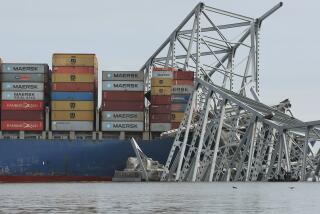California Takes a Bad Spill
- Share via
When the Exxon Valdez tore itself open like a sardine can on Alaska’s Bligh Reef last March, Californians figuratively breathed a sign of relief, saying: “Thank God, it didn’t happen here.” Well, sure enough, less than one year later, something like that has happened here.
As they said again Thursday, accidents happen. But accidents can be prevented, too. And it’s time that the governments of California and the United States take the simple actions needed to minimize the prospects of further mishaps.
Fortunately, the spill from the tanker American Trader off Huntington Beach was not 11 million gallons--only about 300,000. And a fortuitous quirk of wind patterns kept the slick off the beaches for much of the day Thursday. Thankfully, the initial spill-scene response was much quicker and better-planned than in the case of the Exxon Valdez.
But even if our beaches are largely spared, this accident should serve as yet another warning that the magnificent California coastline is always vulnerable to a major oil disaster.
While no one can be certain yet just how the spill occurred, there are some obvious measures that will either prevent future occurrences or limit their impact. The most sensible and logical requirement is that all new tankers be fitted with double bottoms and hulls.
Would a double bottom have prevented the Huntington Beach spill? Probably. Would it at least have kept the size of the slick to a minimum? Absolutely. Does it cost more to build tankers with this double skin? Sure. Is it worth it? Yes, if the American coastline is worth protecting from disaster--and if the oil industry wants to prevent future public-relations disasters.
Americans were promised back in 1973 that tankers carrying Alaskan crude would be double-bottomed. It never happened, apparently because economics overtook environmental concern. But the $2 billion that Exxon estimates it has spent on cleanup costs since last March would have bought a lot of double bottoms and, in the bargain, the coast of Alaska would not still be coated with goo.
Regulators also must look hard at the sort of near-shore mooring and oil transfers the American Trader was attempting when the accident happened. Would it be as economical but safer to require such hookups while docked in port? And both Congress and the state Legislature should quickly complete action on the oil-spill liability and response bills now before them.
Such actions may be costly and add to the cost of energy. But just ask Exxon if the ounce of prevention isn’t better than trying to clean up after a disaster.
More to Read
Sign up for Essential California
The most important California stories and recommendations in your inbox every morning.
You may occasionally receive promotional content from the Los Angeles Times.













